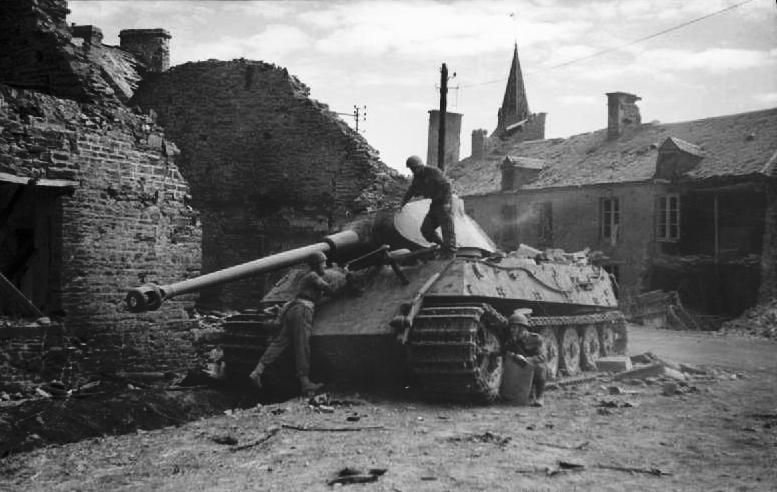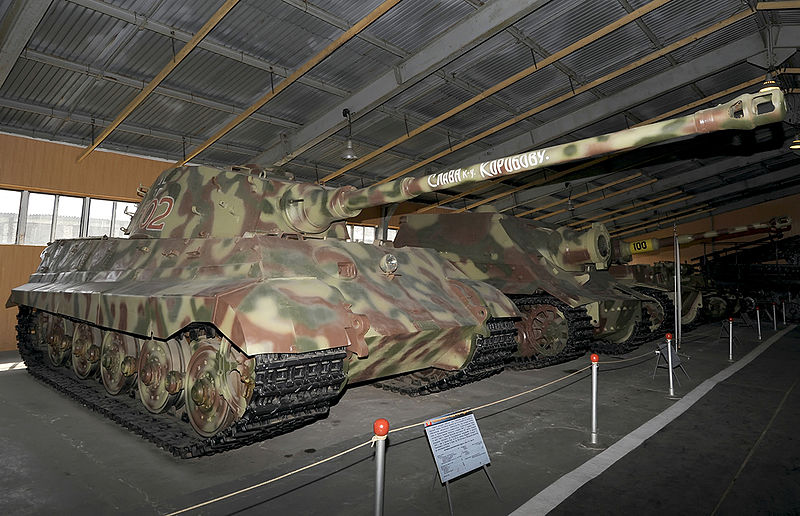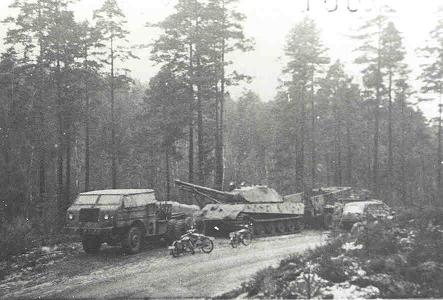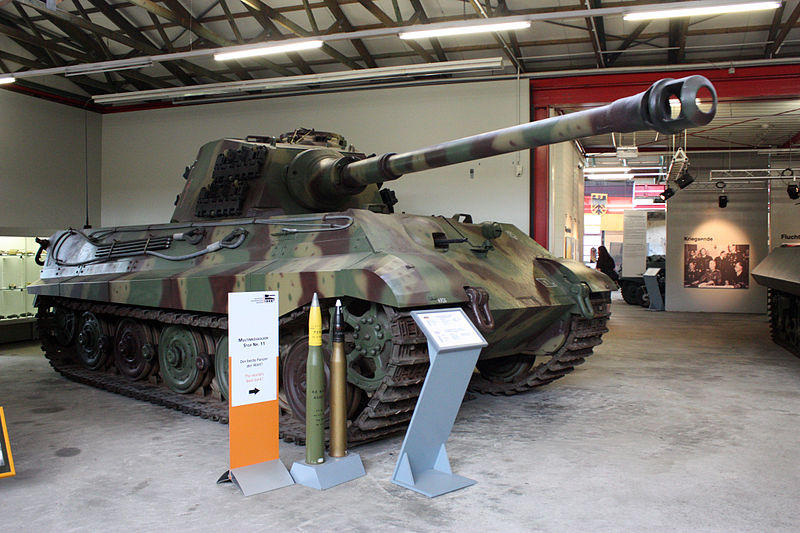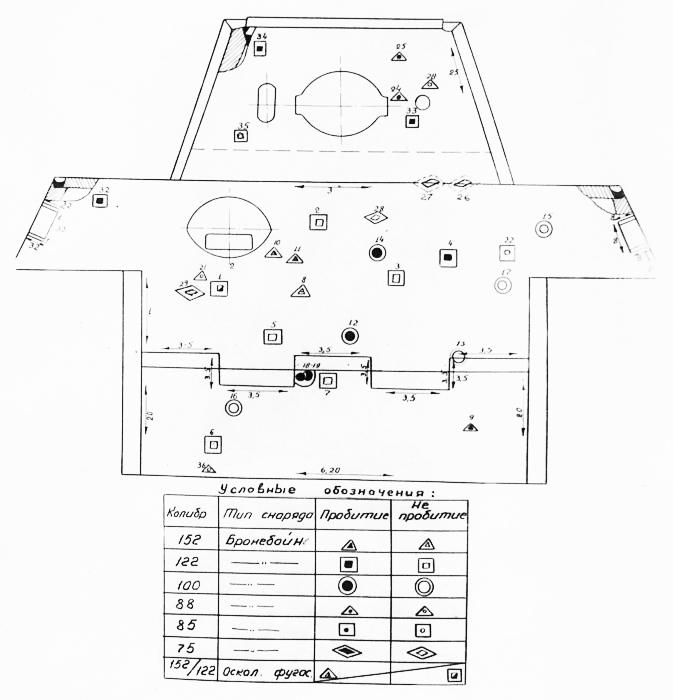Introduction
The King Tiger was one of Hitler’s last gambles, a “Wunderwaffe” (miracle weapon), set to reverse the situation, taking part in the Normandy campaign, in the last major German offensive, Operation Wacht Am Rhein, and in the defense of Germany thereafter. Beyond the propaganda newsreels and its formidable appearance, the last German wartime heavy tank was a very costly, over-engineered, fragile and fuel-glutton lumbering beast prone to breakdowns, since it weighed 20 tons more than the Panther and had the same engine and transmission.
Historians consider it a gigantic waste of skills and resources (for the same price, the Russians were able to deliver 10 T-34/85s). But it also left a deep imprint in tank design, illustrating both what can be achieved at the extreme and what must not be sacrificed. At that time, in early 1944, its protection level made it virtually impregnable from the front, except against the high caliber gun of the Soviet IS-2, provided the latter could come into reach. Indeed, its main 88 mm (3.46 in) L/71 gun had a range of two miles (3 km), with enough accuracy and velocity to hit and get through almost anything. At the end of the war, the equipment planned for this tank (telemetry, stabilized gun and gunner sight, autoloader, IR searchlight) was several years beyond anything in both the East and the West. It was, for some, the first main battle tank.
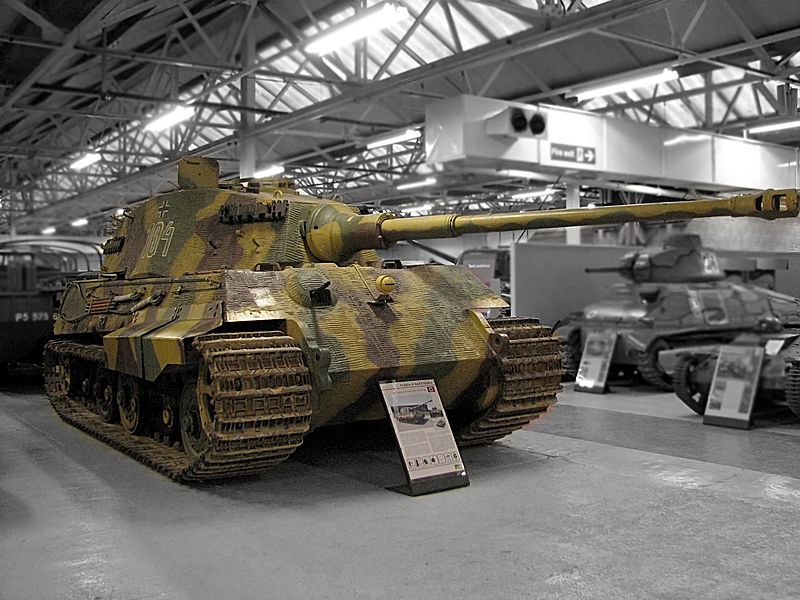
Hitler’s Wunderwaffe
It was thought that the rhythm of technological advancement would render any tank design obsolete within a year. So a replacement was ordered in May 1941, before the Tiger I and Panther were even introduced and before Operation Barbarossa. One year later, the two competitors from the Tiger program were invited to think bigger. Their new projects evolved from the Tiger, but adopting the sloped armor of the Panther, raised to 150 mm (5.9 in), and mounted a brand new turret with a narrow front, inspired from battlefield experience, fitted with, arguably, the best gun of World War Two. German engineers knew they had built the absolute, uncontested champion of the battlefield. The propagandists of the Third Reich were delighted, naming it the “Königstiger”, the Bengal or Royal Tiger.
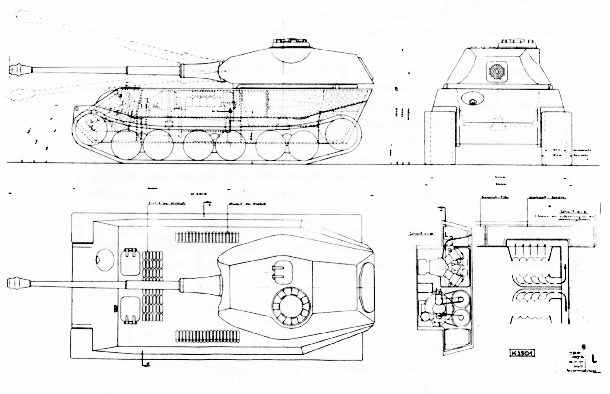
Porsche VK 45.02 prototype design, original blueprint, rear turret model.
Genesis
The Panzerkampfwagen Tiger Ausf.B, ordnance name Sd.Kfz.182, can trace its roots back to when the heavy tank program was initiated in 1937. Two designs competed in the Tiger competition, one from Porsche and another from Henschel. The Henschel project led to the Tiger Ausf.E, but Porsche also received a contract at first. The latter built the Tiger(P) and the tank hunter Ferdinand. Both Tiger prototypes were equipped with a turret (and gun) from Krupp. 1482 Tigers were produced until 1944, and spawned the Sturmtiger self-propelled 380 mm (14.9 in) rocket-assisted howitzer and the BergeTiger ARV. The Tiger soldiered from Tunisia to Italy, France, the Netherlands, Germany, Russia and Eastern Europe and proved to be a formidable adversary and an unflinching foe for Allied crewmen.
But, after the battle of Kursk in the summer of 1943, the Russians unveiled the SU-152, tank hunters like the SU-85, the T-34/85 and the IS-2, that were all capable of destroying the Tiger. The order came in January 1943 for a version of the Tiger capable of carrying the new Rheinmetall KwK 43 L/71 88 mm (3.46 in) main gun, too long for the initial Krupp turret. Specifications also requested 150 mm (5.9 in) of armor at the front and 80 mm (3.15 in) on the sides. Both Porsche and Henschel were contracted. In the meantime, Krupp was dissatisfied by the adoption of a gun built by its rival, and designed its own version of the L/71. It was quite different, but had the same muzzle velocity and penetration performance.

Porsche prototype
Porsche’s VK 45.02(P) had two variants, differing by the placement of the engine, which was either rear-mounted or centrally-mounted. More visibly, the two differed by a rear-mounted (Turm Hinten) or front-mounted turret (Turm Vorne). They employed the same innovative solutions already adopted for the first Tiger(P). The hull was characterized by six bogie-paired road wheels per side and sprung with short longitudinal torsion bars, integrated with the bogie units. It had a gasoline-electric drive, the gasoline engine powering an electric generator, which transmitted power to electric motors that were connected to the drive sprockets. The advantage was a refined gearbox management. Porsche also tried hydraulic drives. However, the problems that appeared with the Tiger(P) prototype back in 1942 were still remembered, and, in addition, copper shortages were critical. Although fascinating as it might seem from an engineering point of view, Porsche’s unorthodox solutions were a nightmare in terms of production, standardization, maintenance and even training. Nevertheless, Porsche confidently presented a mock-up prototype on October, 20, 1943. However, the first 50 Henschel built hulls were equipped with the turret meant for the Porsche design, which had a characteristic curved front plate. On 6, December 1943, an order was given to Krupp to eliminate the curve, in order to eliminate the shot-trap and to ease manufacturing. The mantlet was also redesigned.
3.jpg)
King Tiger with the early Krupp turret design with the curved front on their way to Normandy, France, June-July 1944.
Henschel’s prototype
In the autumn of 1943, Henschel proposed to the General Staff the interim solution of installing an add-on curved bow plate on the Tiger I, but the solution was rejected. Henschel’s development plans for the Tiger II were finished before Porsche’s, in February 1943. They presented a stretched-out Tiger hull with an extra pair of roadwheels and sloped front and sides, like the Panther. Commonality of parts with the Panther was also thought of, for better maintenance and cheaper manufacture. The engine was still the same V12 Maybach unit, conventionally rear-mounted. The nine steel-tired overlapping road wheels on each side were sprung by transverse torsion bars, the same system already used for the Tiger I. Maintenance issues from the previous design were fixed based on field reports, most notably that the roadwheels only overlapped, rather than being interleaved like for the Tiger I. Henschel’s mock-up was presented to Hitler on October, 20, 1943 at Orzysz, in East Prussia.
Henschel was awarded the contract for the successor of the Tiger, officially known as the Panzerkampfwagen Tiger Ausf.B. Preparations were made for production, and three production prototypes (V1, V2, V3) were built in November 1943. Serial production started in December 1943 at the Kassel plant, an order for 1,500 Tiger IIs being placed.
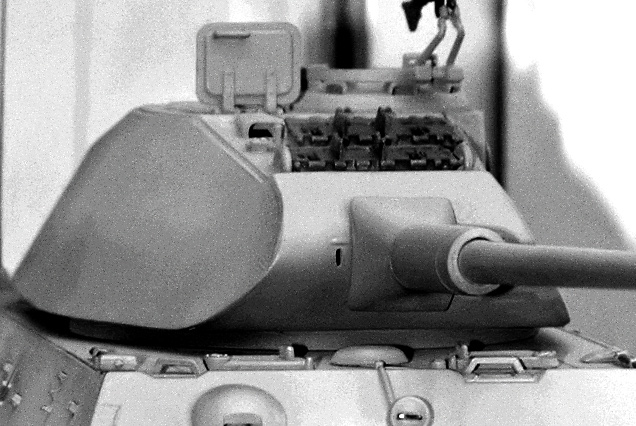
Model of the early Krupp turret design with the curved front at the Panzermuseum Munster.
Production
The prototypes (Nov-Dec. 1943)
The first one, Fgst.Nr.V1, was completed at Henschel in November 1943. It did not have the Zimmerit anti-magnetic coating, nor tooling or tool storage. The front mudguards were flat, with hinged sides extensions. Both the view port and pistol port in the turret sides were welded shut. The turret was of course of the early Porsche model, with its characteristic curved front, while the commander cupola was protruding to the left side of the turret. Both the 80 cm (31.5 in) and 66 cm (26 in) wide tracks were tested on the two others prototypes, essentially similar to the V1. However, the V2 had a handwheel located on the firewall to close vent, in order to allow underwater travel. The V2 will be captured by British troops in Haustenbeck in 1945. It was discovered with its tooling attached but without Zimmerit coating, in plain sand beige livery. All three prototypes were tested until January 1944, and still after when the production was going on, for additional modifications.
Production figures (1943-1945)
Only 12 or less, depending of the sources, were delivered at the end of the month at Kassel. 377 came out from January to December 1944 and 100 more until March 1945, for a grand total of 489 to 492 (with prototypes) tanks in four batches (420500, 420530, 420590 and 420680). They had plenty of common elements with the Panther and Panther II, including the upper hull hatches, among others. It was believed that production could be gradually improved in order to reach 125 tanks per month in the summer of 1945, which never occurred.
Production was severely disrupted several times by shortages of labor, material and because of unrelenting bombing raids on the main plant at Kassel.
In all, five raids severely affected the plant between 22 September and 7 October 1944: 95% of the floor area was destroyed. The estimated loss ranges around 657 Tiger IIs from that alone. Full production peak was attained in mid-1944 and it was sustained until the end of the war.
Albert Speer’s decision to atomize production and the whole supply chain lowered the effect of those bombings. Indeed, Henschel’s suppliers and sub-contractors were Krupp, Wegmann, Skoda and DHHV, which themselves had many sub-contractors throughout the country. As it was said in the introduction, the Tiger II was, without surprise, the costliest German tank built at that time. It needed 300,000 man hours of skilled labor force (and slave labor). The price tag was 800,000 Reichsmark (320,000 US$), the equivalent of the wages, for a week, of a city of 300,000 inhabitants. Below is a comparison of cost between German tanks and Allied models during the war.
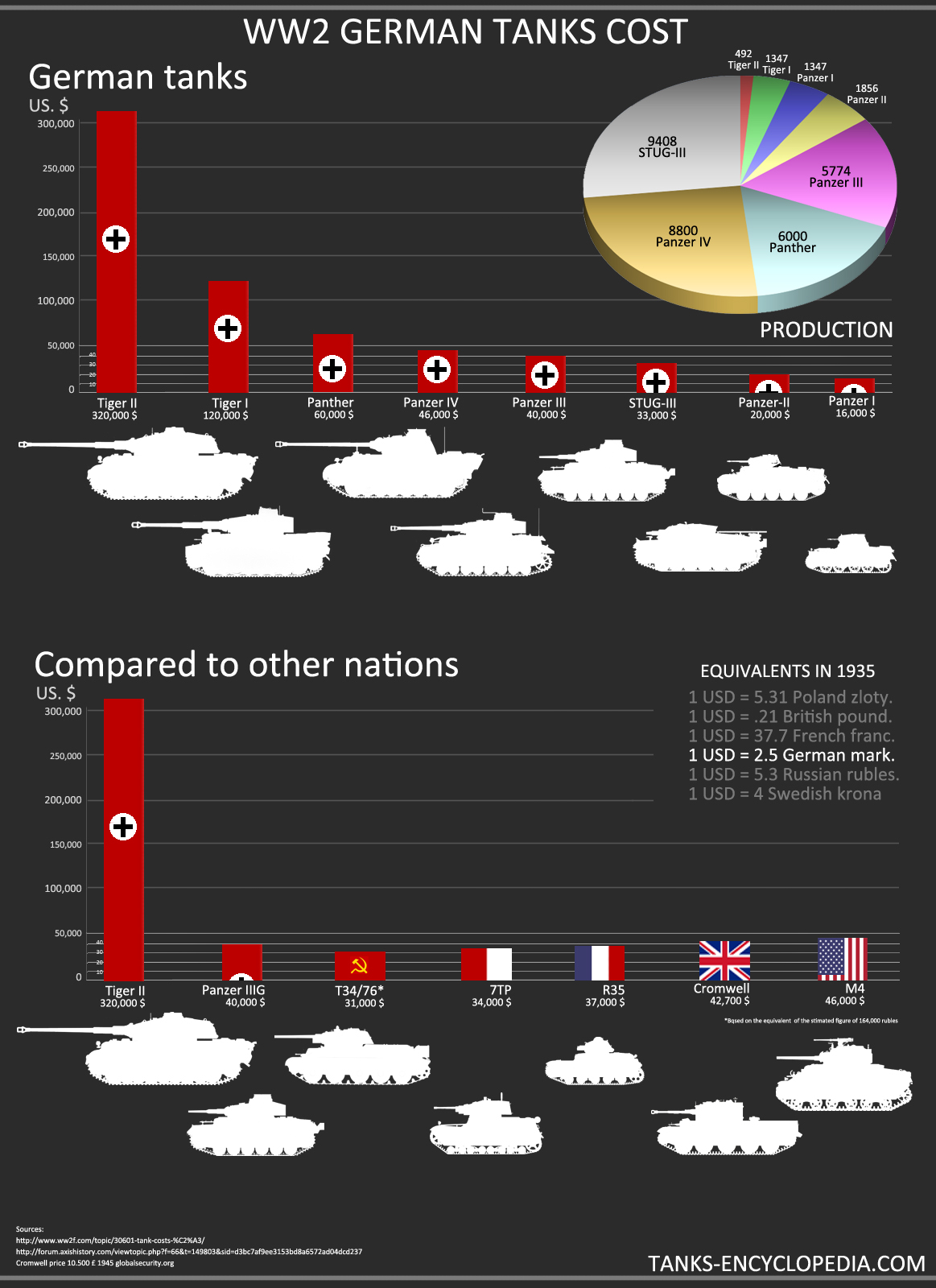
Tiger II & other German tanks cost chart
Modifications during production
Major modifications were the replacement of gaskets and seals, tracks (two models, one for transport only – Verladekette), new sockets for the main drives and additional track links fixations. Experimental modifications were also tried, tested at the end of 1944. In detail, and in respective order from January 1944 to March 1945, these changes included:
-Turm N.1-50 Serien-Turm (Henschel mod.)
-Curved track guards
-Armor pot over the snorkel tubes
-Sheet metal covers for the exhaust pipes
-Curved tail pipes
-Engine coolant heater
-Towing eyes and notches in the glacis
-Turret ring guard
-Vent lines for fuel system
-Monocular TZF9d telescopic sight
-KwK 43 88 mm (3.46 in) sectional gun tube
-Double link tracks with 9 teeth sprockets
-Blade sight for commander
-Pilze sockets for 2-ton jib boom
-Hangers for spare parts and track links
-40 mm (1.57 in) thick loader’s hatch lid
-Poison gas identification panel
-Roof bolted commander cupola
-Modified turret rear armor
-Guards for the torsion bars
-Armor cover over the engine compartment vent
-Patch camouflage painted on primer (no more Zimmerit)
-Four vent lines for the fuel system
-Rain guard for the sight aperture
-Ribbed track guards
-Single link tracks
Engine planned modifications
Since the actual powerplant was overwhelmed by the weight of the hull, Maybach developed early on the HL234, a conversion of the old Maybach HL230 block to fuel injection. The power output estimated was to be 900 PS (hp). The Entwicklungskommission Panzer decided its inclusion, as well as the improved gearbox AK-7-200 instead of the Olvar-B drive train. However, in the end, the Waffenamt research and development department Wa Prüf 6 found it offering less attractive driving characteristics.
Turret planned modifications
Krupp proposed the much heavier 10.5 cm (4.13 in) KwK L/68, still compatible with the internal mounting. However, Wa Prüf 6, as well as the Heer, did not accept the cannon. Planned improvements included a fully stabilized gunner sight, stabilized main gun and a semi-automatic ammunition feed. The Zeiss stereoscopic rangefinder was a bold move, as it would have provided much better accuracy, up to 2.5 or 3 miles (4-5 km). Other modifications planned, but never adopted, included a heated crew compartment, additional ammo stowage for 12 rounds, overpressure and improved air filtration system against poison gas.
Design
Hull
Henschel’s design was very much inspired by the Panther, with the same sloped plates, just thickened to incredible levels. The front glacis plate was originally 100 mm (3.94 in) thick, on the 1942 VK 45.03 design, then 150 mm (5.9 in) strong at 50°, therefore equivalent to 230 mm (9.05 in) against direct fire. This inclination allowed tons to be saved while providing virtual immunity. The same could be said for the sides and rearwards inclined rear plate (100 mm/3.94 in equivalent).
- Driver’s front plate (Glacis): 150 mm (5.9 in) @ 50°
- Lower hull front: 100 mm (3.94 in) @ 50°
- Side: 80 mm (3.15 in) @ 25°
- Rear: 80 mm (3.15 in) @ 30°
- Roof: 40 mm (1.57 in)
- Belly; Front: 40 mm (1.57 in)
- Belly, Aft: 25 mm (0.98 in)
The driver was located on the left hand side and had a single piece hatch, which opened by traversing to the front, swinging around the left-corner. A handbar was present on the opposite corner. The hull machine-gunner/radio operator’s seat was located to the right. He had a similar hatch, but swinging around the right corner. The driver was given a single traversable periscopic sight protected by an armored cover on the initial design, which was the same as on the Panther. It was then changed for a Fahrersehrklapp, a rotating cylinder with direct vision, in January 1943, and a visor was cut into the glacis plate. The radio operator/hull gunner had a small sight coaxial to the machine-gun mount and his own fixed periscope (winkielspiegel), complete with its cast armored cover. The MG 34 was fired through a ball-mount (MG Kugelblende) protected by a cast armor guard. In all, for the coaxial MG 34 and the optional AA tank commander ring-mounted extra MG 34, nearly 5,800 rounds were stored, not including the magazines for the MP 40 close combat sub-machine gun.
On the fighting compartment floor, underneath the turret basket platform that traversed with it, were located the ammunition bins, fitted with sliding metal panels and kept closed at all times. Capacity was lowered to 80 rounds when those in the turret basket were eliminated for safety. Extra panniers built-in the hulls sides (above the tracks) allowed extra HE and AP rounds to be carried with the same system used for the turret basket ammo storage, 6 rounds front, 7 middle and 11 rear on each side.
There was no room for external storage boxes. The sloped sides, which covered up to half of the track width (complemented by a catwalk over which the side skirts were attached), had handling hooks and straps for two towing steel cables (32 mm/1.26 in diameter, 8.2 m/27 ft long) running from the rear to the front, with hooking eyes locked on each end. On the rear were installed a 20-ton steel jack with lifting housing and folding crank at the rear (and its wooden block), and two C-hooks. On the left were located a wrecking bar, starter hand-crank, a spade and three cleaning rods. On the right side were located 3 more cleaning rods and an extra 15 m (49 ft) long, 14 mm (0.44 in) diameter steel cable, and. In addition, a 2-liter extra fire extinguisher, axe, sledge hammer and wire cutter were located on the engine deck.
There was a single blackout lamp and headlight, on the center of the front plate.
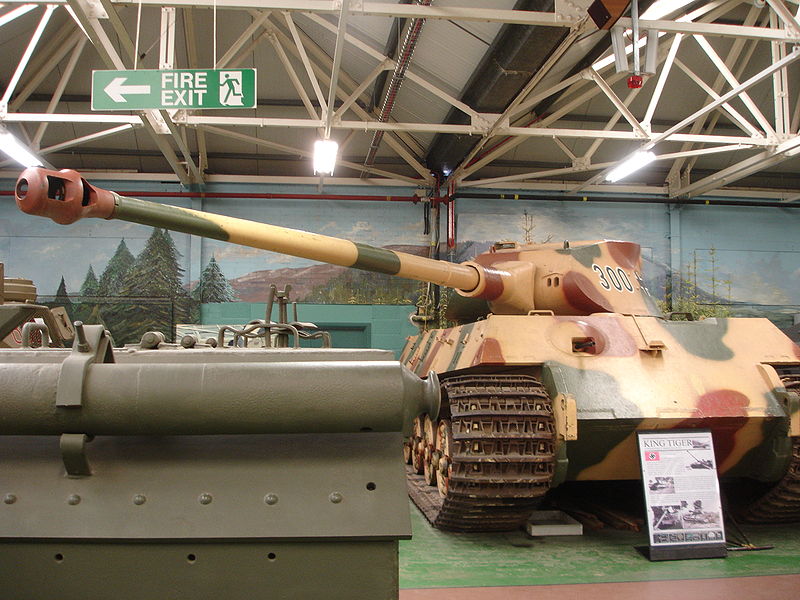
King Tiger, early type with the early Krupp turret design with the curved front at the Bovington museum.
For added strength, the plates made of laminated steel RHA were welded after being built-in, locked in place together. Postwar studies, based on units reports, shown that no Tiger II was ever penetrated frontally, although, in theory, it could have been defeated by the British 17 pounder using a special APDS ammunition. Chances of an encounter between two such vehicles were of course statistically small, and no such battle ever occurred. But even in this case, the shell had tendencies to bounce off the inclined armor, which further diminished any chance of such a kill.
_Bovington_Henschel_turret.jpg)
Propulsion
Building a new engine capable of 1000 hp would probably have made the Tiger II the first main battle tank, years in advance. However, such speculations leave out the fact that above 50 km/h (31 mph), due to the roadwheels and torsion bars used, the suspension would have certainly been torn apart. The Tiger had to content with the same Maybach gasoline V12 HL 230 P30 which developed 700 PS (690 hp, 515 kW), with a 23 liters capacity (145 mm stroke, 130 mm bore). It had a compression ratio of 6.8 to 1, rated 600 hp at 2600 rpm. The very same engine was used by the Panther. It was coupled with a governor that activated the second stage of the carburetor (at 1600 rpm) and regulated the engine speed. The air flow trapped dust in two compartments on both sides of the engine. The cleaned air passed through an oil bath, which removed any remaining impurities.
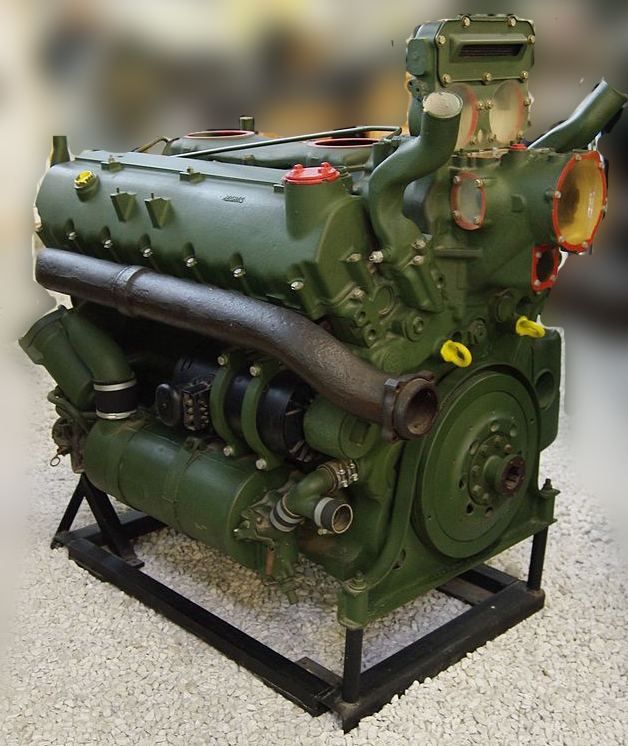
Maybach HL 230 at the Technikmuseum Sinsheim.
Filters had to be cared for each time the tanks were refuelled, and more frequently in sandy/dusty conditions. Two mechanically driven fuel pumps (of the membrane type) were found on the left side of the engine, with the fuel line having its highest point above the maximal level of the fuel tank, coupled to an air vent system to prevent a siphon effect. The whole engine compartment was cooled down by a regular air flow, ventilated from radiators fans drawing air through a duct in the left bulkhead. The exhaust lines were connected to pipes in the rear plate through a double ball and socket joint, in order to not interfere with the engine movement inside. They were also protected by heavy cast armor shields and the tail pipes were surrounded by metal sheet shielding.
This engine was coupled with a Maybach OLVAR water-cooled EG 40 12 16 B gearbox, providing the driver with eight forward and four reverse speeds. The pre-selective shifted transmission allowed a maximum of 3000 rpm (ungoverned), or a maximum of 41.5 km/h (26 mph) for the 8th gear and 11 km/h (6.9 mph) in reverse. Power-to-weight was only 10 hp/tonne (8.97 hp/ton). The breaks could be engaged either by lever or pedal. The lever could be locked for emergency extra steering. The brake housing rotated, as the lining was held only in contact with the brake discs. The effect was exerted on 29 ball bearings and six springs. The brake discs were 66 mm (2.6 in) in thickness, and had to be replaced after decreasing to 58 (2.3 in). For the final drives, each shaft had two double herring bones reduction gears, which were connected to similar gears insensitive to small frictions. Both drive housings were symmetrical and therefore interchangeable. Revolution reduction was assumed by a large spur gear and then a planetary gear, which formed the reduction shaft. The bell-shaped drive sprocket wheel was cast, secured by ten screws and eight bolts.
Suspensions
The overlapping suspensions consisted of eight inner and ten outer pairs of roadwheels, all metal-rimmed. Each roadwheel suspension arm was connected to a torsion bar inside the hull, through a large articulated plastic bushing, which prevented mud and water from infiltrating. The first and last of these units were much stronger. The roadwheels were made of single strong stamped sheet pieces, which received a soft outer steel rim and two layers of rubber in between, for better cushioning. The roadwheels were fastened to the hub (connected to the torsion arm) using two conical discs divided and held together by a thumb screw. The ribs for the inner and outer roadwheels were different, but they had similar roller bearings. There were also two forward shock absorbers connected to the two forward roadwheel suspension arms, and two rear ones located near the lower forward fuel tanks. They were composed of a rubber bump stop for the upper torsion arm movement.
Tracks
Famously, the Tiger II used two types of tracks, the narrow transport version (Verladekette), 66 cm (26 in) wide and the regular field version (Gleisketten), 80 cm (31.5 in) wide. The first weighted 42.9 kg compared to the cross-country tracks of 62.7 kg. It was composed of 46 double links connected by double track pins which had a head inside and a locking ring on the outside. The latter was secured by a retaining pin fitted through a hole in the track pin. Each track link consisted of one bridge link, one connecting link, three side links, and two track pins. Grousers can also be added for extra grip and reduce further ground pressure.
Performance
The Tiger II had a ground clearance of 495 to 510 mm (1 ft 7.5 in to 1 ft 8.1 in), and a fuel capacity of 860 liters (190 imp gal), giving an operational range of 170 km (110 mi) only on good roads, less on muddy or snowy terrain and slopes. Cross country it was still 120 km (75 mi). However, its top speed on road was 41.5 km/h (25.8 mph), with a sustained, cruising speed of 38 km/h (24 mph). Cross country speed was between 15 and 20 km/h (9.3 to 12.4 mph). The Tiger 2 was a known gas-guzzler. Many were lost in defensive battles after running out of gas.
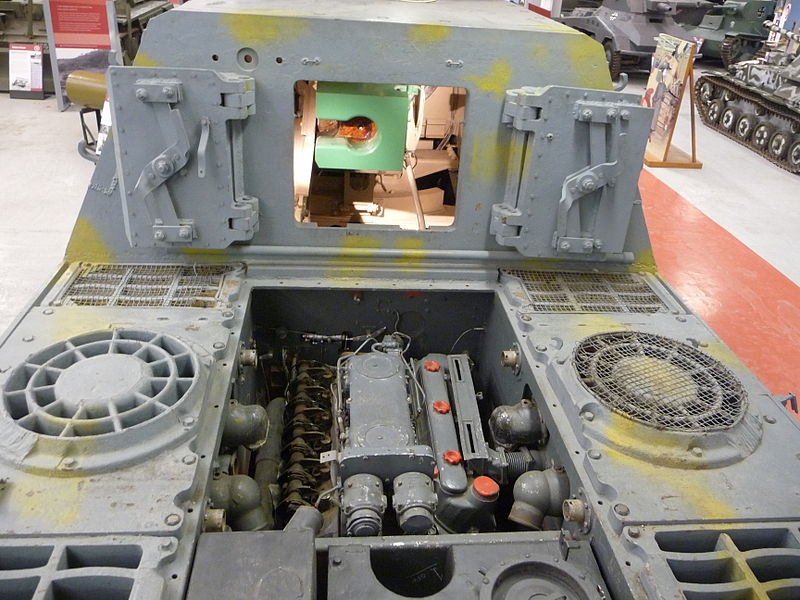
Maybach HL 230 seen from the deck of the Jagdtiger.
Equipment
The electrical system on board consisted of a starter, ignition device, a generator, batteries and a battery heater. The generator was the main source of electrical power, using the main engine motion. It also charged the batteries and fed all devices on board. The voltage was maintained by a regulator independently of the engine speed, and also managed the battery charging through a governor. It had an automatic switch depending on the voltage level, and the commutator was cooled by a fan to prevent overheating. The Bosch starter had a primary electric motor with adjustable armature shaft and pinion connected through the friction clutch, and a two-voltage setting. It required 24 volts in order to work properly. The switch system comprised two batteries of 12 volts, each connected in parallel in order to get to the proper voltage. In addition, the master switch battery was located on the firewall and could be activated by the crew. All lines were fuzed, and on the panel were 2×8 15 amp and 2×40 amp fuzes. The panel had an extension for a hand-held light and junction box for extra plugins. There was also a 300 watt battery heater, which could be connected to an external source through the firewall or the batteries themselves could be connected externally to a power supply.
There was an automatic fire extinguisher inside the engine compartment, with its pipes heading to the carburetors and fuel pumps. It used CB agent sprayed through four nozzles, having a reserve of three liters, sufficient for five discharges (7 seconds bursts). They were triggered by heat sensor heads connected to the nozzles, reacting at 120°C. The discharges were linked to a timer once the fire was detected and, if not extinguished, the burst continued. There was also a hand-crank starter installed just above the electrical starter as a backup, as a flywheel gear could be activated by the crew through a hand-crank. The engaged pinion then disengaged itself when the engine started. It could be accessed through a small opening on the hull rear and protected by an amour cover below the right hand exhaust pipe. Behind the middle of the engine crankshaft there was also a gasoline engine starter. The fuel tanks were on the upper rear side of the engine (85 l, gravity fed), two on the upper left-right of the engine compartment (290 l), two in the bottom of the engine compartment (65 and 80 l respectively) and two left and right of the fighting compartment, underneath the ammo boxes (350 l).
Turret
Both the turrets were designed and built by Krupp, but they are regularly designated as Porsche (the first, curved model) and Henschel (the latter model). It is worth noting that neither Porsche, nor Henschel built any turrets.
As it was shown before, the very first series was equipped with the already available and completed early Krupp turrets with the curved front, characterized by their curved front meant for the Porsche design. Although handsome and giving some extra protection, this design was quickly eliminated because of shot-trap issues and manufacturing complexity. On the Serienturm (January 1944), the front was cut out and replaced by a slightly sloped plate. Production was simplified, but, from a purely ballistic perspective, it offered a larger, thus more vulnerable hitting surface.
However, both turrets shared the same general design, with a 30 mm (1.18 in) thick roof plate, and the lozenge shape (seen from above) of the turret. Both the commander and loader were located in the center (the ammunition was stored behind). The commander was seated on the left hand side, behind the gunner, and had a fully traversable cupola with seven vision blocks providing good peripheral view, and a machine-gun mount was mounted around the circular hatch, which could be opened to the left. The ring mount added additional protection when the commander was out. He was given an adjustable seat.
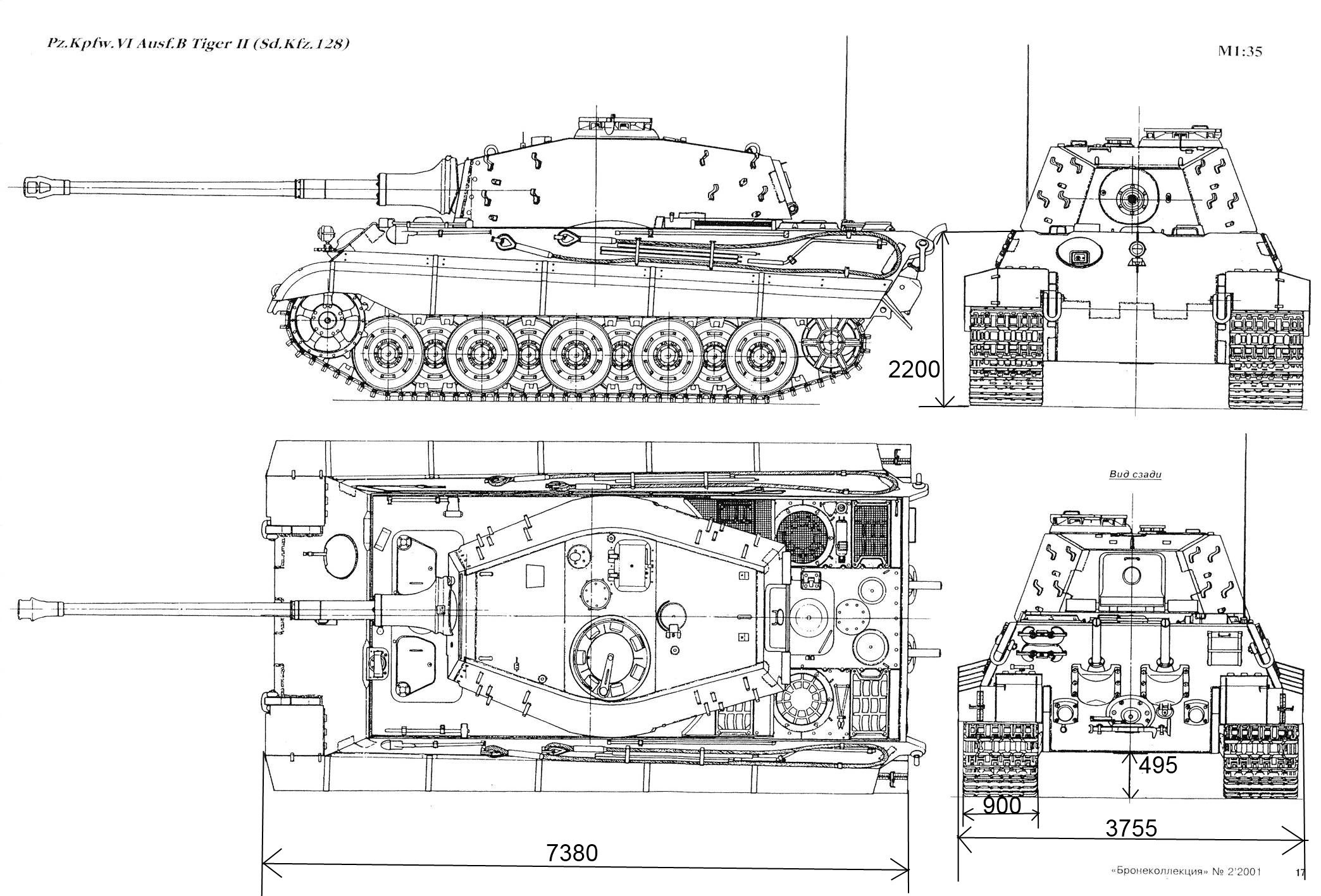
The loader’s hatch was on the right, single-piece, with a rounded but rectangular lid, opening forward. It could be sealed watertight, thanks to a submarine-type door handwheel. The loader also had a periscopic sight (prismenspiegel), protected by an armored cover, further forward on the front slope of the roof. Between the two was located the main ventilation and fume extraction port. Behind the loader’s hatch, in the centreline, was located the spent ammunition ejection port (manual). At its rear-right was located the Nahverteidigungswaffe port (close defense weapon), which had a spring loaded firing pin, which was held in a cocked position.
The turret drive was hydraulic, taking power from a split drive shaft between the engine and transmission, through a reduction gear, which could be engaged at will. There were two traverse speeds, engaged by a hand lever connected to the hydraulic drive. This allowed also a coarse laying of the gun, completed by the gunner engaging handwheels.
Both turrets had a MP-stopfen (pistol port for the MP-40) and a schauloch (view port) only on the left side. On the front-left hand side of the gun were located the two stepped apertures for the gunner’s binocular gun sight, with a rain channel welded over. On the other side was located an aperture for the coaxial MG 34, with a maintenance hatch cover. The ammunition was stacked in the rear pannier over rails and held in place by quick-disconnect bands type clamps. The rear top hatch, located on the back plate, was blocked by the upper ranks of ammunition, and was used only for loading. The whole turret rear wall was removable. During production, two sets for four (two upper, two lower) hand hooks were welded on the plate to support spare track links, which provided extra protection on the front and rear sides of the turret.
Turret detail armor (Serienturm)
- Gun mantlet: 150 mm (5.9 in) @ 13°
- Front: 110 mm (4.33 in) @ 10°
- After 51st Turret: 180 mm (7 in) @ 10°
- Side: 80 mm (3.15 in) @ 21°
- Rear: 80 mm (3.15 in) @ 20°
- Roof: 25/40/25 mm (1/1.57/1 in) @ 50°
- After 51st Turret: 40 mm (1.57 in)
Interestingly enough, the gun was not centered, but slightly offset to the right, to make room for the gunner’s binocular sight.
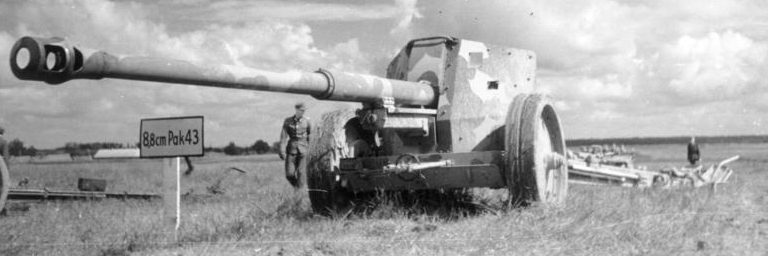
The Rheinmetall 8,8 cm Pak 43 L74, after which Krupp designed its tailored L71 model for tanks.
Armament
The core and heart of the Tiger II was it L71 KwK 43 8.8 cm (3.46 in) main gun, already used by the lightly armored and open-topped Hornisse and the more formidable Ferdinand/Elefant, both tank hunters, which proved how lethal the gun could be in ideal conditions. For the first time, a tank was tailored to use this gun, and the 360° traverse allowed for a better use of its capabilities. This was Krupp’s replica of the Rheinmetall KwK 43 L/74, already in service as an antitank gun since mid-1943. The difference was not only that it was shorter, but had different rifling and a new, more efficient muzzle brake. Its recoil cylinders were shorter, fatter, in order to fit inside a turret. In addition, an air blast system was fitted to evacuate fumes from the gun directly after firing. The ammunition was tailored for its, with a shorter and thicker cartridge case for easier loading.
Ammunition
- PzGr 39/43 (Armor piercing, tungsten core) (longer range, lower penetration, explosive filler)
- PzGr 40/43 (Armor piercing, tungsten core) (shorter range, higher penetration, inert)
- SprGr 43 (High Explosive)
- HlGr 39 (Hollow charge)
80 rounds (early turret) or 86 rounds (Serienturm) were stored, some in the turret basket and others in the cavernous hull. In general, half were PzGr 39/43 and the other half SprGr 43, sometimes with a few PzGr 40/43 or HlGr high explosives, depending on the mission.
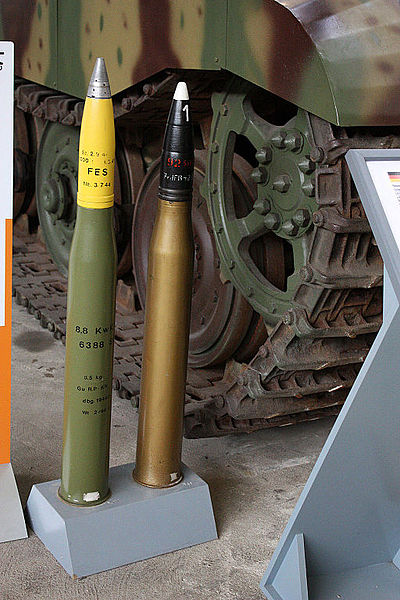
In order to fully profit from the gun’s accuracy, it was combined with the Turmzielfernrohr 9b/1 (TZF 9b/1) until May 1944 (German for “turret telescopic sight”), manufactured by Leitz, which all but a few early Tiger IIs used. It was replaced after May 1944 by the 9d (TZF 9d) monocular sight. Practice data showed a first hit capability, on a 2 x 2.5 m (6ft6 x 8ft2) target, of 100% at ranges beyond 1,000 m (0.62 mi), falling to 95–97% at 1,500 meters (0.93 mi) and 85–87% at 2,000 m (1.2 mi). Of course, this depended on the ammunition type. Recorded combat performance, however, usually showed figures of 80%/1,000 m, 60%/1,500 m and 40%/2,000 m. Penetration figures against armored plates inclined at 30 degrees were 202 and 132 mm (8.0 and 5.2 in) at 100 m (110 yd) and 2,000 m (1.2 mi), respectively, for the Panzergranate 39/43 projectile. The PzGr AP (armor piercing) shell could pierce between 238 and 153 mm (9.4 and 6.0 in) at the same ranges. The Sprenggranate 43 (SpGr) was mostly intended for infantry support.
Secondary armament comprised two Rheinmetall Machinengewehr 34 or 42 (7.92 mm/0.31 in), with up to 5,850 rounds stored inside the tank. Another machine-gun was usually mounted around the commander cupola.
| 88 mm KwK 43 L/71 penetration data* | |||
| PzGr. 39/43 (APCBC) | PzGr. 40/43 (APCR) | Gr. 39/3 HL (HEAT) | |
| Shell Weight | 10.2 kg | 7.3 kg | 7.65 kg |
| Initial velocity | 1000 m/sec | 1030 m/sec | 600 m/sec |
| 100 m | 202 mm (7.95 in) | 238 mm (9.4 in) | 90 mm (3.54 in) |
| 500 m | 185 mm (7.28 in) | 217 mm (8.54 in) | 90 mm (3.54 in) |
| 1000 m | 165 mm (6.5 in) | 193 mm (7.6 in) | 90 mm (3.54 in) |
| 1500 m | 148 mm (5.8 in) | 171 mm (6.73 in) | 90 mm (3.54 in) |
| 2000 m | 132 mm (5.2 in) | 153 mm (6 in) | 90 mm (3.54 in) |
*Source: Jentz, Thomas L., King Tiger Heavy Tank: 1942-1945
Coating and camouflages
There was an evolution starting with the first deliveries in April-May 1944. Tanks were initially factory-painted with Dunkelgelb (RAL 7028 or olive sand), and the crew applied camouflage patterns of large spots or stripes in deckpasten colors of Olivgruen (RAL 6003 olive green) and Rotgrun (RAL 8017 reddish brown). After 19 August 1944, camouflage was entirely factory-applied after pre-established patterns, and, from 9 September 1944, Zimmerit was no longer applied at the factory. The camouflage was factory-applied over the base red oxide primer coating of the hull and turret. The green and brown were sprayed directly onto it, without dunkelgelb base. In March 1945, a buntfarbenanstrich (multicolored) pattern was established by spraying Rotbraun or Olivgruen in sharp contours over the factory components already provided, covered in Dunkelgelb. Turret interiors were painted with Elfenbein (RAL 1001 or ivory). However, starting with the first deliveries until August 1944, interiors were painted with the Leuchtfarbenanstrich or “luminous paint”.
The famous “ambush pattern”, or Tarnanstrich, was first issued on 19 August 1944. Over a Dunkelgelb base, the green and brown were factory-painted (not sprayed) in patches, with characteristic smaller spots of opposite tones. The crews, upon reception or at the depot, also freely improvised or improved the camouflage, which added to the diversity observed through photos of the time.
.jpg)
Tiger II in Budapest, 1945.
The Tiger II in action
How could five hundred tanks change the balance of forces, when facing a maelstrom of tens of thousands of Allied tanks east and west? Hitler strongly believed that their quality could overcome any quantity disadvantage. On paper, the Tiger II was impregnable to anything, and the 88 mm (3.46 in) was capable of dealing with any Allied tanks easily and beyond their reach. But what really talked against the King Tiger, which the public never knew, was that they were fuel-hungry and had, so to speak, “short legs”. They were perfect for a limited offensive, with full support, as a spearhead. But it was clearly unsuited for the type of actions that were very successful for the Germans, like when Guderian launched his Panzerdivisions through the Ardennes in May 1940. It could have crossed the awful terrain encountered in the Ardennes forest, but couldn’t cross the improvised bridges launched over the Meuse, and to finish with, would have lumbered well behind the rest of the divisions or would have delayed them so much, when racing to the sea, that the Allies would have plenty of time to organize counter-attacks. Was it better prepared for the various operations of 1944-45? Let’s see.
Tactically, Tigers were integrated into the Schwere Panzer Abteilungs (s.H.Pz.Abt.), heavy tanks battalions of forty-five tanks in full strength. Each of these comprised three companies, twelve tanks strong, or three platoons of four Tigers. At the head of each company was a command unit of two tanks, while the Heavy Battalion itself was headed by a general command unit of three Tiger IIs. The exception was the Panzer Lehr division, which was given four Tiger IIs. Ten Abteilungen were affected to the Heeres (from 501 to 511) and three to the SS (s.SS.Pz.Abt), the 501, 502, and 503.
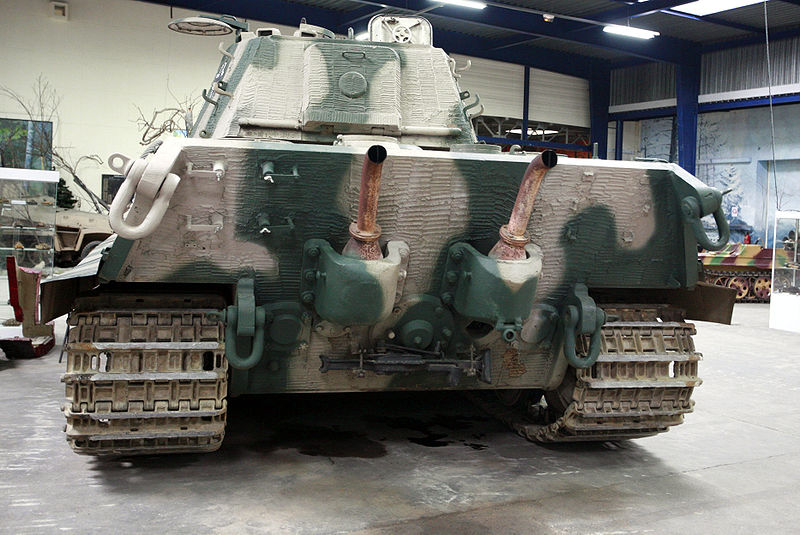
King Tiger seen from the rear, Saumur tanks museum.
Normandy, France
The first recorded combat use was registered by Kings Tigers from the 1st Company, 503rd Heavy Panzer Battalion, pitted against British Forces between Troarn and Demouville, on 18 July 1944. Two were combat losses, plus the company commander’s tank (trapped in a bomb crater created during Operation Goodwood), and never recovered. This was also the first Allied encounter and capture of such a tank. Losses during Operation Goodwood were indeed appalling. Allied photographs immortalized Tiger IIs flipped over like toys, after being pounded by 550 to 1015 lbs (250 to 500 kg) bombs. One of the last ditch offensives of Tiger IIs in the sector involved Operation Lüttich, on 7 August, in the vicinity of the town of Mortain. Efforts were made to cut through the American 30th Infantry Division. The XLVII Panzer Corps, one half of a SS Panzer Division and two Wehrmacht Panzer Divisions were also involved in the operation.
.jpg)
s.Pz.Abt.503, later nicknamed “Feldherrnhalle”, posing in formation for the German newsreels, prior to departing for Hungary, 1944.
After six days of intense fighting, most of the German forces had been destroyed, partly by U.S. 9th Air Force reinforced by the RAF Second Tactical Air Force. RAF’s Hawker Typhoons, deployed as tank-hunters, proved excessively successful when using their 80 mm (3.15 in) rockets, especially against the not particularly well protected roof and engine deck. German forces had inflicted between 2000 to 3000 casualties, but 150 tanks were left in the field, while infantry losses are unknown, but certainly comparable. Until August, 21, the last efforts to mount a coherent defensive action in the Falaise Pocket area were jeopardized, again, by the action of the Allied aviation. The remnants of the Wehrmacht that did not cross the providential gap between the US and British forces (mostly due to Montgomery’s excessive caution to avoid friendly fire), were comprehensively annihilated.
Ardennes, Belgium
Most amazing was the deployment in December 1944 for operation Wacht am Rhein (Guard on the Rhine), Hitler’s last gamble to cut the Allied armies in half and throw them into the sea. For this major and totally surprising counter-offensive, Army Group B, under command of Generalfeldmarschall Walter Model, totaled 90 Tiger IIs mobilized with the 501st SS Heavy Panzer Battalion, attached to the 1st SS Panzerdivision, the 506th Heavy Panzer Battalion (sixth Panzer Army), reinforced by the 301st Heavy Panzer Battalion (9th Panzerdivision). The latter had 27 Tigers on 16 December, of which only 14 were battle ready, the others still in repairs. At that stage, on paper, and despite all the publicity made about these, only 90 Tiger IIs and about 100+ Tigers were thrown into the offensive, although the Abteilung was filmed abundantly in German newsreels. This “wunderwaffe” was considered as the tip of the spear, but the plan proved fatally flawed, as it imposed the capture, at precise schedules, of all fuel supplies of the Allied Forces just to allow the tanks to stay mobile until the end of the first phase, up to the Meuse River. In addition, the 653rd heavy Panzerjäger battalion would also have been committed, fielding most of the Jagdtigers built by then. But these tank hunters never made it to the front, blocked on their rail carriages, cut off by an air attack, way beyond the Rhine.
One of the more important kampfgruppe commanders was Joachim Peiper, Himmler’s protégé, decorated with the Knight’s Cross and a hardcore nazi, which was judged for war crimes after the war, for the Malmedy massacre and other executions in Poland, Russia and Italy. A veteran of the LSSAH, he served with the 1st SS Panzer Regiment in Normandy. For Wacht am Rhein, he was given the strict order to get to the Meuse river whatever the cost, by the 6th Panzer Army HQ commander Fritz Krämer. Peiper complained about the narrow, hilly and tortuous nature of the road, and his column suffered badly from breakdowns. He had to chose another path through Hünningen and then the Baugnez crossroads, stumbling upon US artillery observers, quickly rounded up and later executed. Arriving at night on the left bank of the Amblève River, he lost a day waiting to assault the lightly defended town. US Forces, in the meantime converged, and blasted all bridges on the Amblève, trapping Peiper’s Tigers in the deep valley of the Amblève, downstream from Trois-Ponts. He then assaulted Stoumont, but was repelled and forced to withdraw to the small village of La Gleize, with his fuel tanks dry. There, he held out six days of US counter-attacks and bombardments, and lost contact with other units. On 24 December, he decided with his men left to join the German lines on foot and his tanks were abandoned, unscathed.
.jpg)
Tiger IIs of the early type on their way to Normandy, France, in June 1944.
Eastern Front
On 12 August 1944, the 501st Heavy Panzer Battalion (formerly in Tunisia, but reconstructed in July 1944 at Ohrdruf) participated in defensive actions alongside Army Group North Ukraine, during Operation Bagration. It later took part in the Lvov–Sandomierz Offensive, attached to the 16th Panzer Division, and attacked the Soviet bridgehead over the Vistula River, near Baranów Sandomiersk. Three Tiger IIs were destroyed in an ambush by a few T-34/85s on the road to Oględów and reports about ammunition stowage that provoked explosions spawned the decision to ban main gun rounds from the turret, reducing capacity to 68 rounds. Around 14 Tiger IIs of the 501st were lost in the area until the 13th, especially to ambushes by IS-2 tanks and ISU-122 assault guns in a prepared terrain of their choice. After the battalion commander was replaced, the 501st was attached to the XXXVIII Panzer Corps and took part in the battles of Radom, Sandomierz and Kielce, and losses were compensated by arrivals of Tiger Is from the 509 sPzAbt. The unit was renamed the 424th sPzAbt and took part in the Vistula–Oder Offensive (12 January 1945), but most were lost during a poorly planned far forward offensive, and those left broke down when back. The remnants of the unit and others regrouped at Grunberg and were eventually carried by train to Paderborn. Some were left to fight there, with the 512th Heavy Tank Destroyer Battalion.
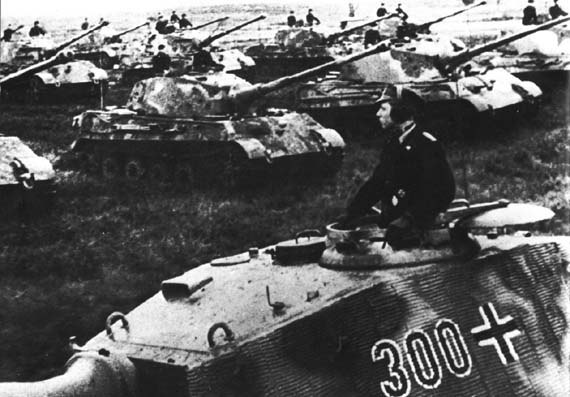
Tiger 2 of the Schwere Panzer Abteilung 503 departing for Hungary, 1944.
On 15 October 1944, the 503rd Heavy Panzer Battalion tanks supported Otto Skorzeny’s troops in taking Budapest (Operation Panzerfaust), to ensure the country stayed with the Axis until the end of the war. Later on, the unit took part in the Battle of Debrecen and stayed on the Hungarian front for 166 days, claiming 121 Soviet tanks, 244 anti-tank guns and artillery pieces, five aircraft and a train for the loss of 25 Tiger IIs. Ten of which had been knocked out by Soviet troops and thirteen were blown up after breaking down, to prevent their capture.
The 503rd was also famous for the world’s top tank ace, Kurt Knispel, that destroyed 162 enemy AFVs and was killed in action on 29 April 1945. Also in Hungary, Tiger IIs participated in the battle of Lake Balaton in March 1945. In total, King Tigers of the 103rd SS Heavy Panzer Battalion claimed approximately 500 kills from January to April 1945 for the loss of all their tanks, abandoned, destroyed after mechanical breakdowns or just for the lack of fuel and spare parts. When only considering proper battle losses, that kill ratio was superior to any other tank in the German army, and possibly superior to any tank ever. The last remnants of the unit in Budapest fought on to try to get through Soviet forces (Operation Konrad). However, the unit globally maintained a 15:1 ratio for insignificant combat losses and is viewed as the second best of all German units in WW2. Another unit which was involved in the combat in Hungary (Operation Konrad III) was the former 509th S.Pz.Abt. decimated, then re-equipped with Tiger IIs in January 1945. It lost 40 out of 45 tanks, trying to get through the ferocious Soviet Pakfront. However, until February they managed to destroy 203 Soviet tanks, among others. The remnants were transferred to the IIIrd Panzerkorp in March 1945, taking part in the fighting supporting Operation Frühlingserwachen.
In Latvia (Kurland), the 510th Heavy Panzer Battalion, re-equipped with Tiger IIs, fought on in the pocket until May 1945. Another unit soldiering on the Eastern Front was the former 102 SS S.Pz.Abt. which was almost wiped out in Normandy, before being re-equipped with Tiger IIs in September 1944 and renamed the 502nd SS Schwere Panzer Abteilung. This unit was stationed on the Oder front line and later tried to get through the Soviet encirclement of Berlin. The remnants were destroyed in the Halbe Pocket. Another former SS unit operating with Tiger Is in February 1944, fought with the IIIrd (Germanic) SS Panzer Corps until October. It was then re-equipped with Tiger IIs in November, and renamed the 503 s.Pz.Abt., taking part in the Army Group Weichsel, operating from February to March. In April, the 503rd had destroyed 500 enemy tanks for the loss of 39.
Germany
In December 1944, the Tiger II participated in the Soviet Vistula–Oder defense, and in the East Prussian defense in January 1945. Several units also participated in the the Battle of the Seelow Heights in April 1945, and the Battle of Berlin thereafter. Since October 1944, it was considered to equip the turrets with a fully stabilized mount, a semi-autoloader gun breech, a brand new stabilized periscopic sight (Turmvinkelzielfernrohr 3), or an 1.6 m wide Entfernungsmesser (interference telemeter).
Overall performances
Tiger IIs straight from the depot proved unreliable, as leaking seals and gaskets were the cause of many failures and breakdowns, and the overburdened drivetrain also often broke. The double radius steering gear was too fragile, and the effect of rushing units to the front with unskilled young drivers only aggravated these issues, in particular when the latter often literally learned their trade on the way to the front.
As an example, the s.Pz.Abt. 501, when first deployed on the Eastern Front, was left with only eight out of forty-five Tiger II in battle readiness, all the others being stranded because of drivetrain failures. For the few Panzer Lehr tanks, it was even worse. All five broke broke down and had to be were destroyed to prevent capture, without firing a single shot.
The Soviet forces captured two Tiger IIs in pristine condition in August 1944, and had them driven back to Kubinka, suffering several breakdowns en route. It was detected that the engine cooling was insufficient, causing the gearbox to overheat and fail too. There, at Kubinka, they were tested against the 122 mm (4.8 in) D-25T, resisting several hits, whereas the 88 mm (3.46 in) L/71 was capable to pierce through the turret of the other Tiger II at 400 m (440 yd). Other rounds of 100 (3.94 in) and 152 mm (6 in) were tested against it, at several ranges. The 100 mm (3.94 in) BS-3 and 122 mm (4.8 in) A-19 gun AP rounds penetrated the turret at 1000-1500 m (0.62-0.9 mi). It was observed, however, that the welding was of poor quality, creating much spalling when the plates were hit, to the point of damaging the transmission beyond repair. There were also deficiencies in quality for the steel plates and castings. In particular, metal analysis showed that molybdenum was replaced by vanadium in the steel composition, due to the lack of supplies, making it more brittle.
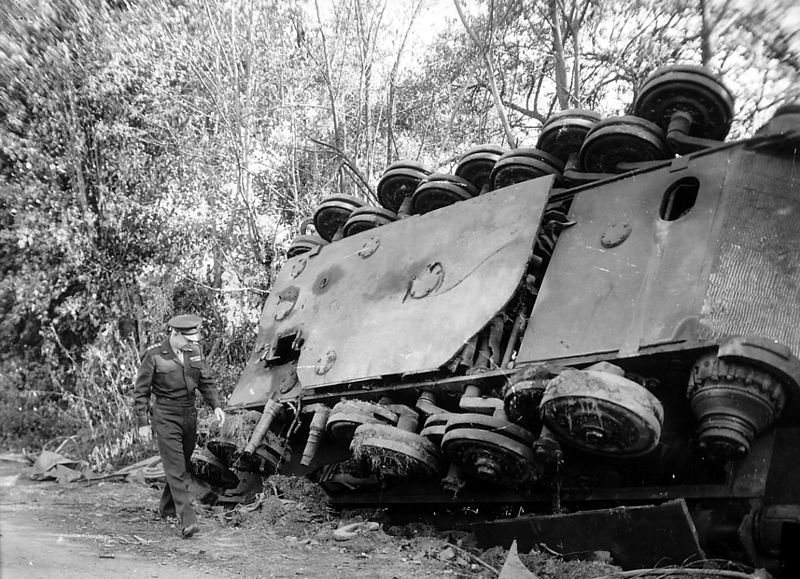
Tiger 2 swapped over in Chambois, Normandy, (after operation Goodwood) inspected by General Eiseinhower, August 1944.
Like the Panther and first Tigers, these reliability issues were corrected over time, at the factories. Modified seals, gaskets and strengthened drive train components were provided both to the newly-built Tigers, as well as upgrades for depots. Measures were taken for improved driver training and better maintenance drills. From 15 December 1944, the statistics show much improved reliability. 80 percent of Tiger IIs were fully operational, as compared to only 61% of Panthers and 72% of the always reliable Panzer IVs. Subsequent failures, all duly noted, were attributed only to the lack of lubricants and spare parts, a common fate shared by all units until May 1945.
For that reason, the Tiger II battle readiness, when engaged en masse, made it quite effective, especially in the Ardennes, and would have been instrumental in a breakthrough, leading to a second “race to the sea”, if the objectives were taken as scheduled. Until May 1945, and despite dwindling numbers, the Tiger II proved to be quite a formidable battle tank in spite of its problems, just as planned. It was even noted to be remarkably agile on muddy and snowy grounds, and its tactical mobility was equal if not superior to many German and Allied tanks alike. Today, 11 tanks still exist. Two are in running order at the Saumur museum, exhibited each year at the summer carousel, along with others at Bovington, UK, Wheatcroft Collection, Leicestershire (private coll.), Kubinka Tank Museum, La Gleize, Belgium, Deutsches Panzermuseum Munster, Germany, Schweizerisches Militärmuseum Full, Switzerland, and the US Army Patton Museum of Cavalry and Armor, Fort Knox. A wreck at Mantes-la-Jolie in France was partially excavated in 2011 under regional road 913. There are no plans yet to recover the wreck completely.
Variants
Panzerbefehlswagen Tiger Ausf.B
This command version externally differed very little from the regular tank. It had two versions, Sd.Kfz.267 (FuG 8 and FuG 5 radio sets, long rod antenna on the turret roof and Sternantenne D mounted on an insulated base on the rear deck) and Sd.Kfz.268.(FuG 7 and FuG 5 radios, 2 m rod antenna on the turret roof and 1.4 m rod antenna on the rear deck). Both carried only 63 88 mm (3.46 in) rounds, the extra space being used to accommodate the extra radios and equipment (extra electrical generator and batteries). Additional armor was also fitted in the engine compartment.
Panzerjäger Tiger Ausf. B
The latter was the heaviest, best protected, most heavily armed tank ever to fight during World War Two operationally. This was a SPG, consisting of a large armored box containing the gargantuan 128 mm (5 in) KwK 44 L/55 with some limited traverse, protected by up to 250 mm (9.84 in) of armor around the mantlet, frontal casemate and glacis. Although weighing in excess of 71 long tons (76 short), it shared the same chassis, engine, drivetrain and transmission (also used on the Panther), and therefore suffered more heavily from breakdowns and fuel shortages. Only 88 were built from July 1944 to May 1945 by Nibelungenwerk.
Links and resources about the Tiger II
Vk 45.02 to Tiger II: Design, production & modifications. Doyle, Jentz
Spielberger, Doyle: Tigers I and II and their variants
The Tiger II on Wikipedia
The Tiger II on fprado.com
Tiger II specifications |
|
| Dimensions (L-w-h) | 6.40 (10.28 oa) x 3.75 x 3.09 m (21ft x12ft6 x10ft1) |
| Total weight, battle ready | 69.8 tons (76.9 short tons) |
| Crew | 5 (commander, driver, gunner, loader, radio/machine-gunner) |
| Armament | 88 mm (3.46 in) KwK43 L/71, 86 rounds 2 or 3x 7.9 mm (3 in) MG 34, 5800 rounds |
| Armor | 25 to 180 mm (1-7.08 i) |
| Propulsion | V12 Maybach HL230 P30, gasoline, 690 hp (515 kW) |
| Transmission | OLVAR EG40 12 16B, 8-forward/4-reverse gearbox |
| Suspension | Torsion bars and interleaved wheels |
| Speed (on road – off road) | 41.5 km/h – 20 km/h (25.8 – 12 mph) |
| Operational range (on road – off road) | 170 km – 120 km (110 – 75 mi) |
| Total production | 492 |

The rejected Porsche Type 180 A/B, Tiger P2, as designed in the blueprints. The three other Type 180s (Turm Hinten) had a rear-mounted turret. It was propelled by twin V12 air-cooled engines linked to an electric generator and electric motors located at the rear with the final drives.

Tiger 2 with the early Krupp turret with the curved front meant for the Porsche design, Normandy, July 1944.

Early production King Tiger, from a Schwere PzAbt, Normandy, August 1944.

Panzer VI Ausf.B of the Schwere Panzer Abteilung 505, fall 1944.

King Tiger with the Serienturm.

King Tiger with the Serienturm. Operation Wacht am Rhein, December 1944.
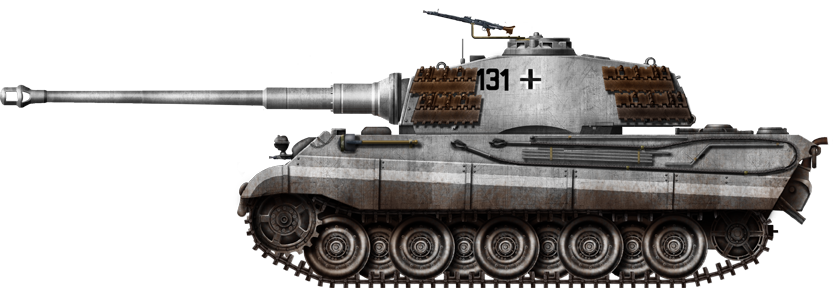
Königstiger with the Serienturm, winter paint, Schwere Panzer Abteilung 503, Hungary, winter 1944-1945.
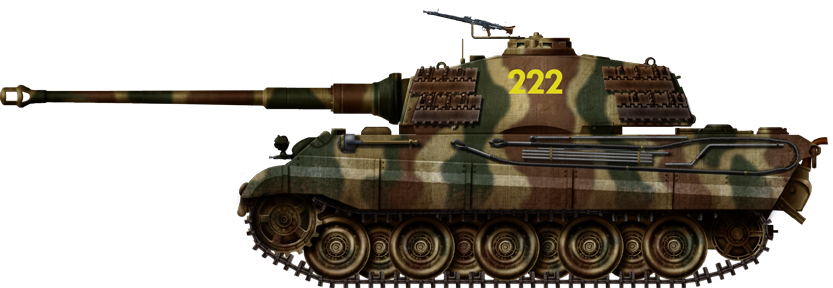
Tiger II 222 from the Schwere Panzer Abteilung 501, Ardennes, December 1944.

King Tiger of the s.Pz.Abt.501 in the Ardennes, Operation Wacht am Rhein, December 1944.

Tiger II of the 3rd Company, 501st Schwere Panzer Abteilung, Poland, August 1944.

Tiger II of the SS Schwere Pz.Abt.501, Ardennes, December 1944.

King Tiger of the Schwere Pz.Abt.506, Germany, March-April 1945.
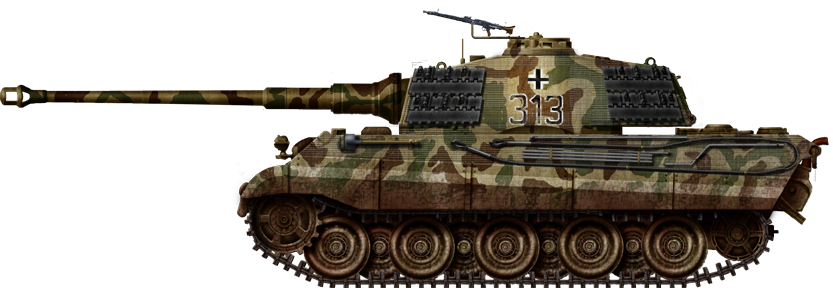
Tiger 2 of the s.Pz.Abt.506, Seelöwe heights, Germany, 1945.
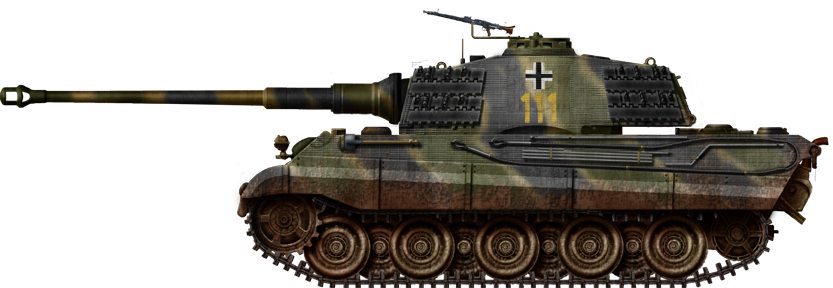
Tiger Ausf.B of the s.Pz.Abt.501 (1st SS Panzer Division), Belgium, December 1944.

King Tiger, unknown unit, ambush camouflage pattern, Germany, April 1945.
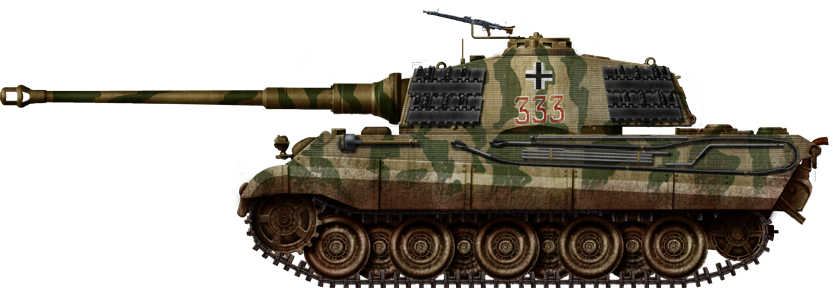
King Tiger of the s.Pz.Abt.501, Germany, Berlin, May 1945.
Gallery

WW2 Tanks




























WW2 tanks posters

All Tiger tanks liveries.

Panther liveries and variants

WW2 Armour - All tanks











Tanks aces and single tanks series

Find more there

Museums, Movies, Books & Games
The Tanks and Armor in pop culture
Tanks and armored vehicles in general are only really grasped when seen first person: The mass, the scale, it's all there. Explore also the way tanks were covered in the movie industry, in books and in video games.Movies:
Best tanks movie on warhistoryonline.com
On imdb.com
On bestsimilar.com/
miltours.com
liveabout.com/
watchmojo.com
Video Games:
pcgamesn.com
historyhit.com
levvvel.com
vg247.com/best-tank-games
mmobomb.com/
alienwarearena.com


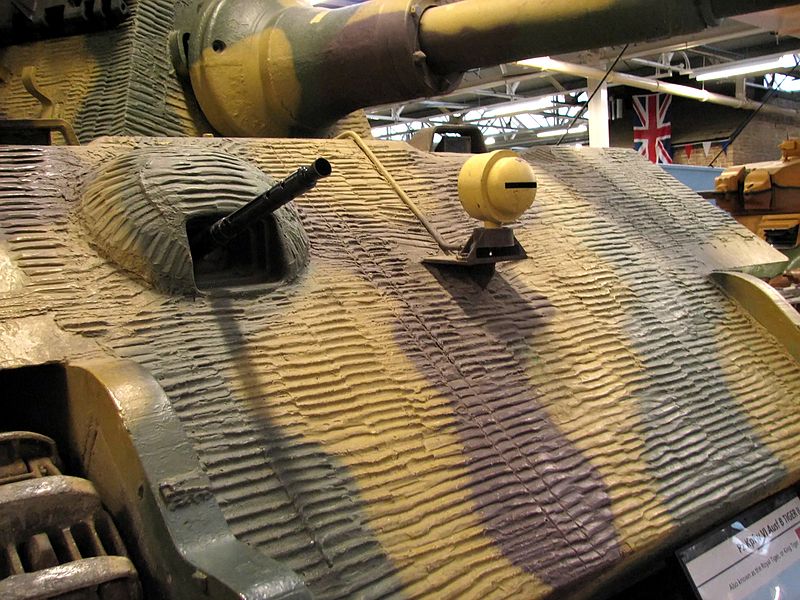
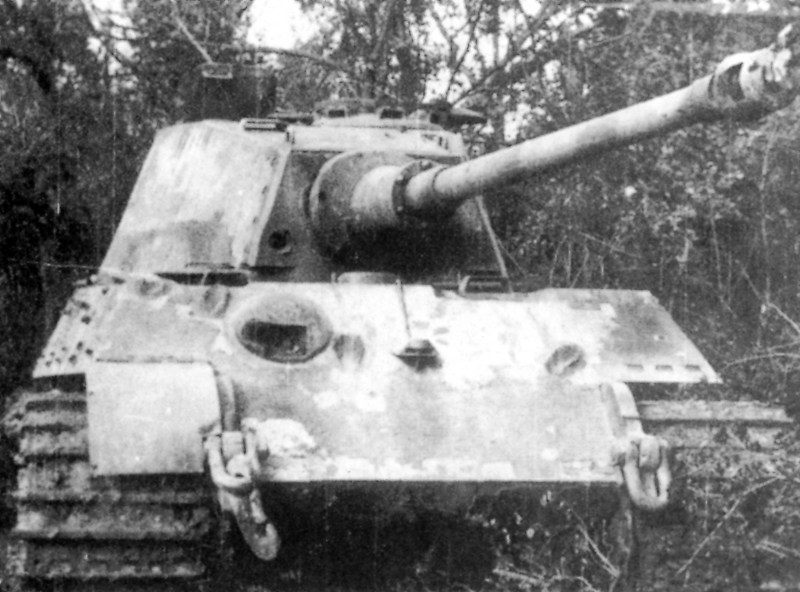
2.jpg)
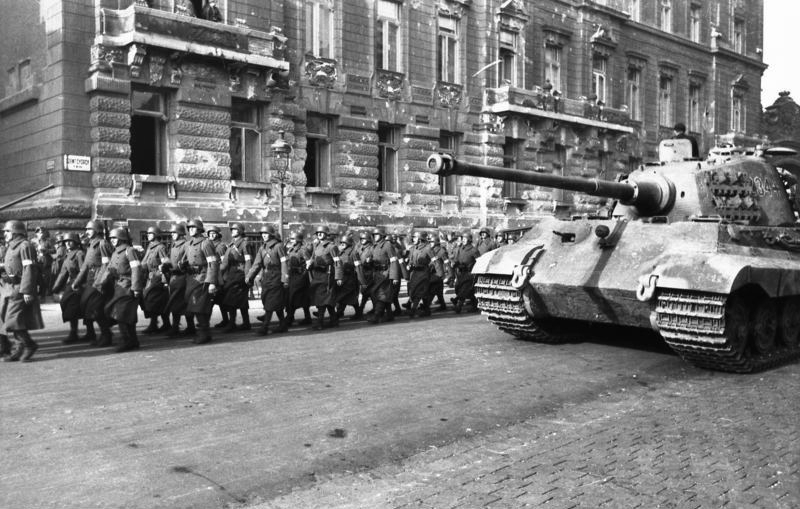
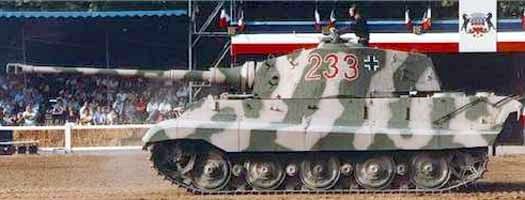
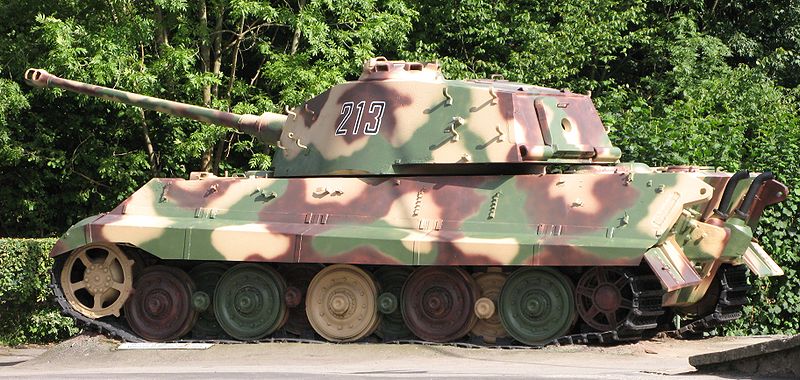
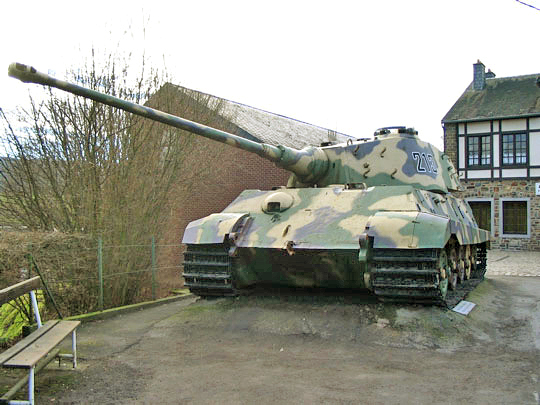
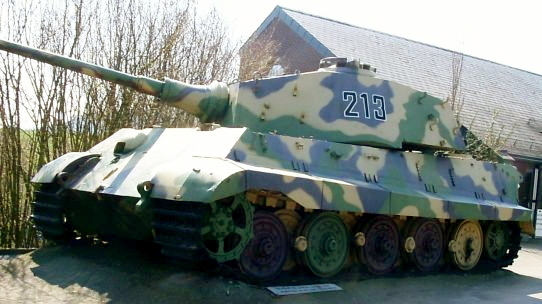
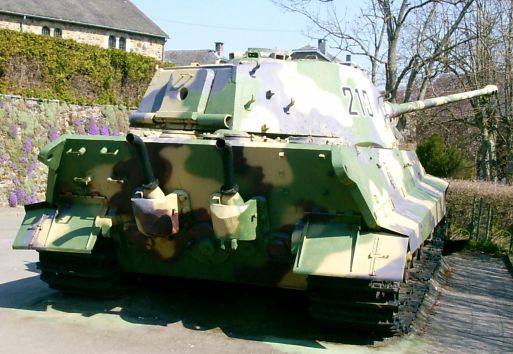
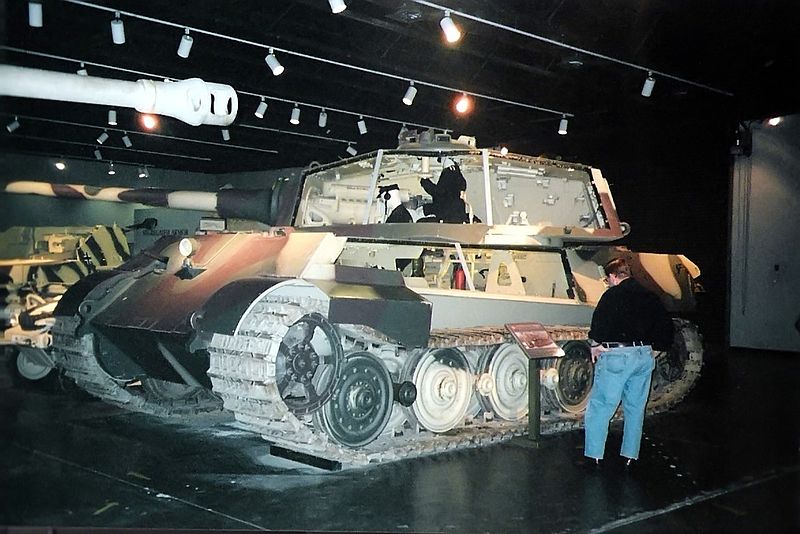
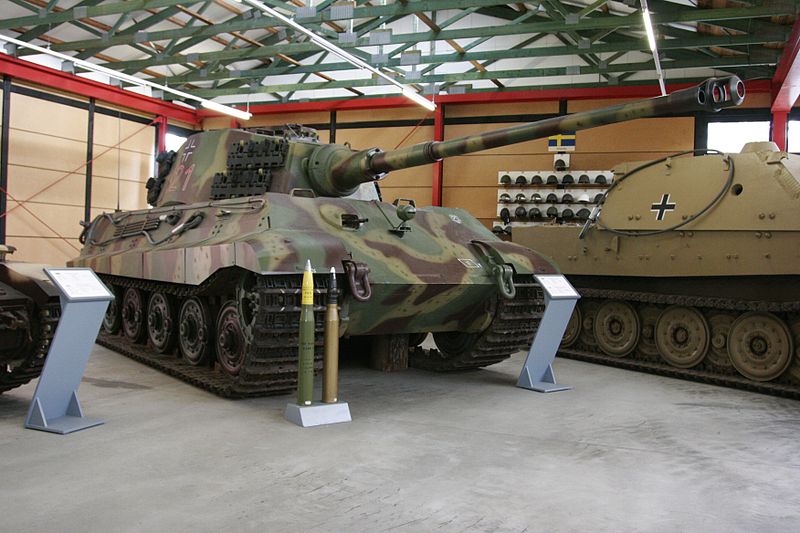
.jpg)
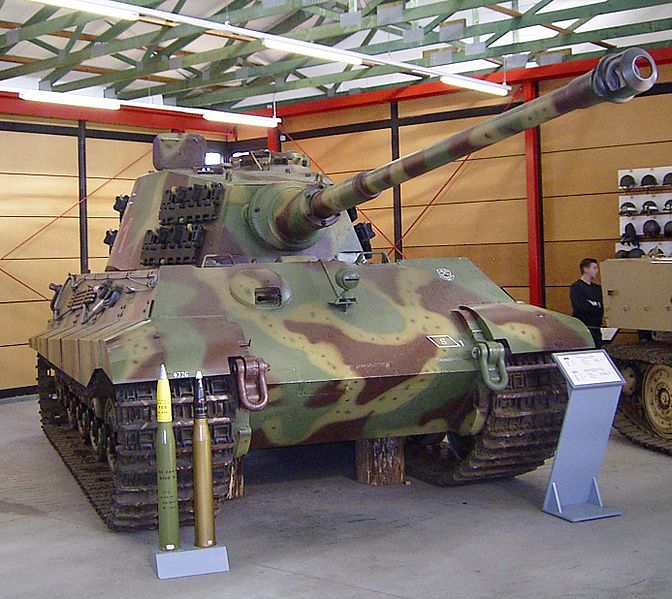
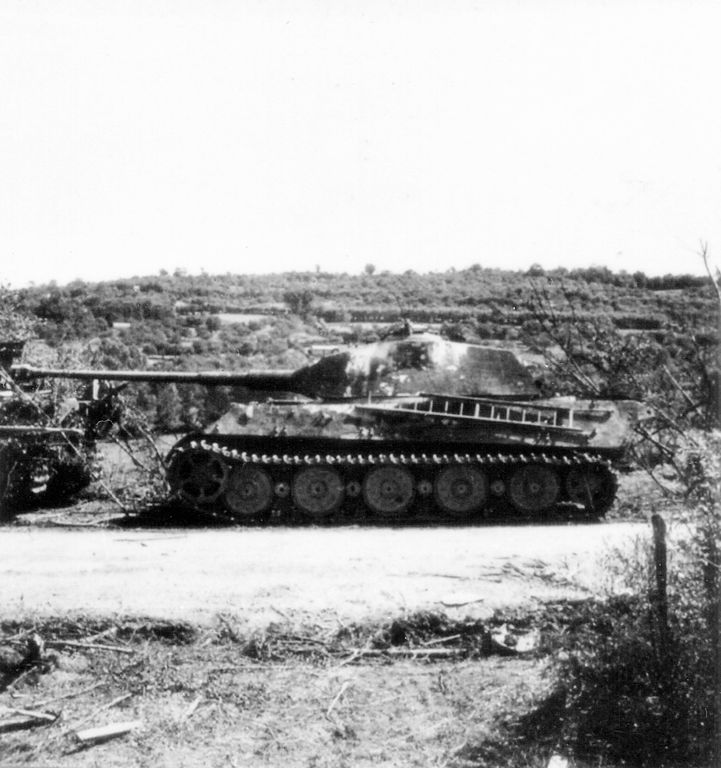
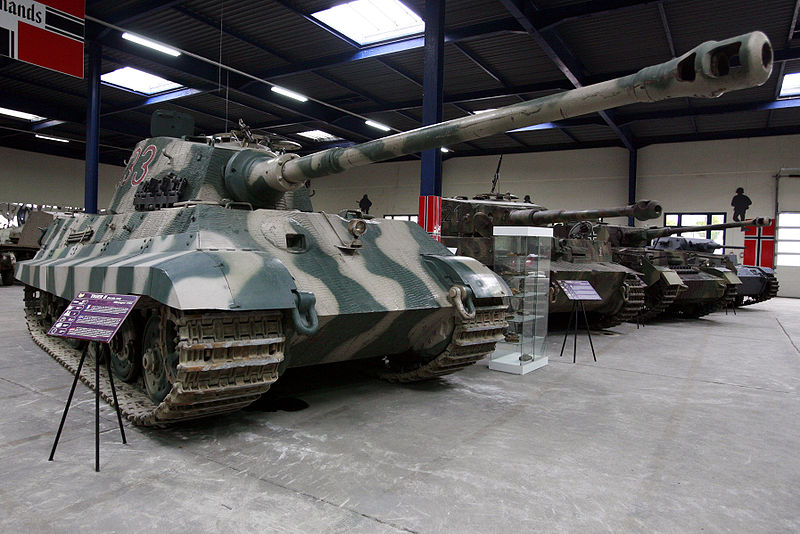
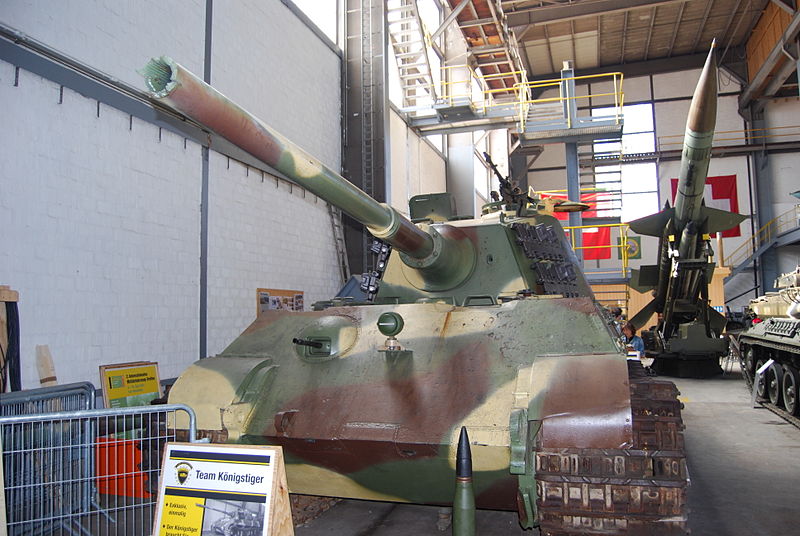
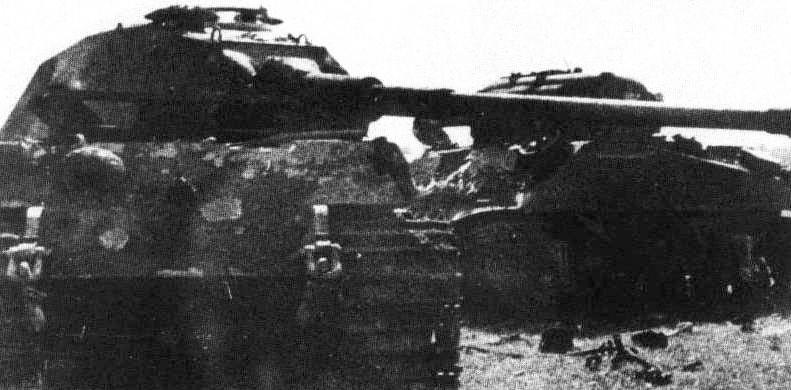
.jpg)
.jpg)
2.jpg)
.jpg)
4.jpg)
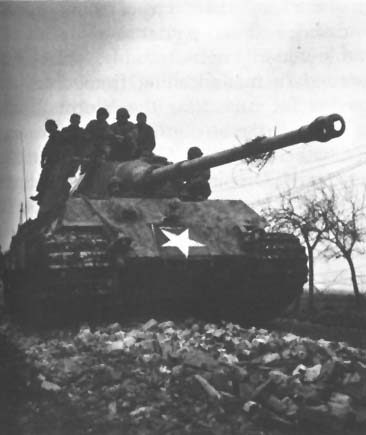
2.jpg)
3.jpg)
